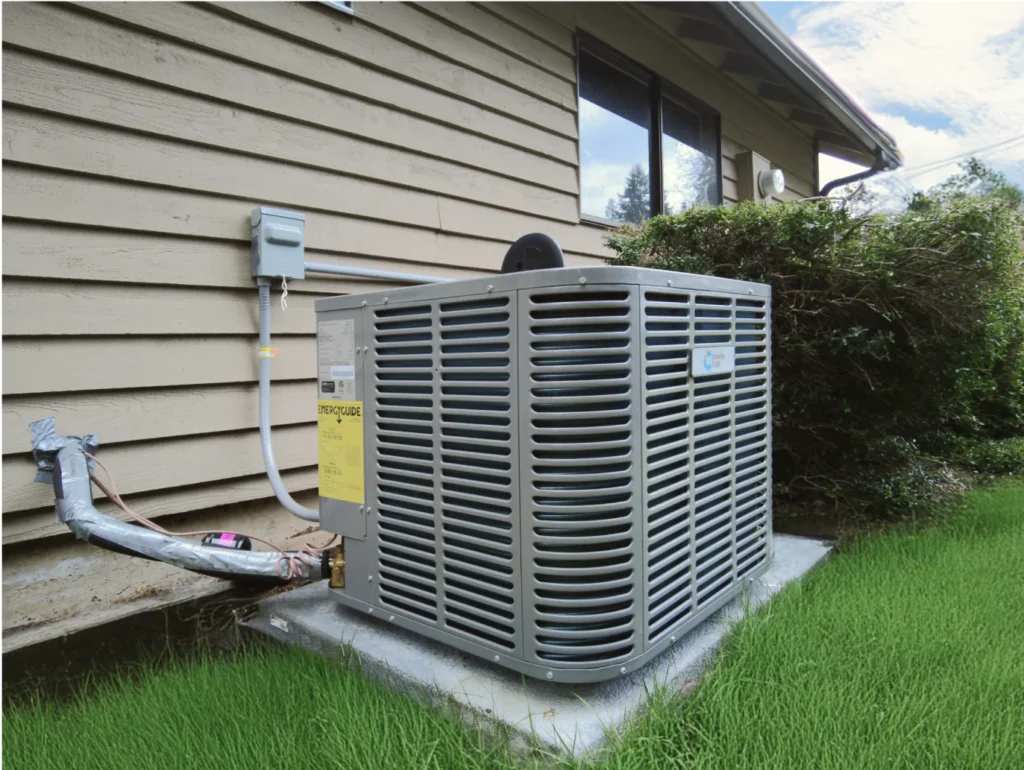Finding the right balance between comfort and energy efficiency in your home can be a real challenge. Traditional HVAC systems often consume more power than necessary, leading to high utility bills and inconsistent temperatures. Whether it’s sweltering heat or freezing cold, these systems can struggle to maintain a steady climate, costing you more money in the long run.
InverterCool HVAC technology is a solution designed to tackle these issues head-on. With its ability to adjust compressor speed based on the actual needs of your home, it offers a smarter, more energy-efficient way to keep your indoor climate just right. This system ensures you get the perfect temperature without the high costs and energy waste associated with conventional HVAC systems.
What Is InverterCool HVAC?
InverterCool HVAC systems use advanced inverter technology to regulate the speed of the compressor, instead of just turning it on and off like traditional systems. This allows the system to adjust its power based on the cooling or heating needs of your home, providing more consistent temperatures while using less energy.
Unlike regular HVAC systems that run at full capacity or shut off completely, InverterCool systems run smoothly at varying speeds, offering better control over your indoor climate. This helps maintain a steady temperature, avoids energy waste, and reduces wear on the system, leading to fewer repairs and a longer lifespan.
Key Benefits of InverterCool HVAC
1. Energy Efficiency
InverterCool HVAC systems adjust the compressor speed to fit your home’s temperature needs, which helps cut down on energy usage. Traditional HVAC systems often run at full power or turn off entirely, wasting energy in the process.
- Up to 30% more energy-efficient than standard HVAC systems.
- Reduced electricity bills over time due to smarter energy consumption.
2. Consistent Comfort
With InverterCool, temperature control is much more precise. This means no more hot or cold spots in your home. The system runs smoothly to maintain an even, comfortable temperature throughout the year.
- No more sudden temperature shifts.
- More stable indoor climate.
3. Quiet Operation
Unlike traditional systems that can be loud, InverterCool systems operate quietly, so you can enjoy a peaceful environment without disruptive noise from your HVAC unit.
- Low noise levels for a more comfortable living space.
4. Environmental Impact
Using less energy not only saves you money, but it also reduces your carbon footprint. InverterCool systems contribute to a greener home by using less power and producing fewer emissions.
- Lower carbon footprint compared to conventional HVAC systems.
Comparison Table: Energy Savings
| HVAC System Type | Energy Usage | Average Monthly Bill | Noise Level | Environmental Impact |
| Traditional HVAC | High | Higher | Loud | Higher carbon footprint |
| InverterCool HVAC | Low | Lower | Quiet | Reduced emissions |
InverterCool HVAC vs. Traditional HVAC Systems
When choosing an HVAC system, it’s important to compare the performance, cost, and efficiency of different models. InverterCool HVAC systems stand out from traditional models in several key areas. Let’s break it down:
1. Energy Consumption
InverterCool systems are designed to use less energy. They adjust the compressor speed according to the cooling or heating requirements of your home. Traditional HVAC systems, on the other hand, run at full power or completely shut off, wasting energy during the on/off cycle.
- InverterCool: Up to 41% more energy-efficient.
- Traditional HVAC: Constant high energy use, especially during on/off cycles.
2. Maintenance
Traditional HVAC systems require more frequent maintenance because the constant on/off cycling puts extra strain on the compressor and other components. InverterCool systems, with their variable speeds, experience less wear and tear, leading to fewer maintenance needs.
- InverterCool: Less maintenance required, longer lifespan.
- Traditional HVAC: More wear on parts, requiring frequent repairs.
3. Lifespan
Since InverterCool systems run more efficiently and with less strain, they tend to have a longer lifespan. Traditional systems often burn out faster due to the constant on/off operation and higher energy consumption.
- InverterCool: Longer lifespan, better reliability.
- Traditional HVAC: Shorter lifespan due to frequent cycling.
Comparison Table: InverterCool vs. Traditional HVAC
| Feature | InverterCool HVAC | Traditional HVAC |
| Energy Consumption | Up to 41% less energy | High energy usage |
| Maintenance | Less frequent repairs | Requires regular repairs |
| Lifespan | Longer lifespan | Shorter lifespan |
| Noise | Quiet operation | Louder operation |
By comparing these key aspects, it’s clear that InverterCool HVAC systems offer long-term benefits over traditional models, making them a better investment for homeowners looking to save on energy and maintenance costs while improving comfort.
Understanding SEER2 and HSPF2 Ratings
When shopping for an HVAC system, you’ll likely come across terms like SEER2 and HSPF2. These ratings are essential in determining the energy efficiency of a system, so it’s important to understand what they mean.
1. SEER2 (Seasonal Energy Efficiency Ratio 2)
SEER2 measures the cooling efficiency of an HVAC system over an entire cooling season. The higher the SEER2 rating, the more efficient the system is at cooling your home while using less energy.
- Higher SEER2 ratings (like 16 or more) = better energy efficiency.
- Lower SEER2 ratings = higher energy consumption and increased costs.
2. HSPF2 (Heating Seasonal Performance Factor 2)
HSPF2 measures the heating efficiency of a heat pump. Like SEER2, a higher HSPF2 rating indicates better energy efficiency during the heating season.
- Higher HSPF2 ratings (such as 8.5 or more) = more efficient heating and lower energy bills.
- Lower HSPF2 ratings = less efficient heating, leading to higher costs.
Why SEER2 and HSPF2 Matter
These ratings help homeowners choose HVAC systems that align with their needs and climate. If you live in an area with extreme heat or cold, look for systems with higher ratings to save on energy bills and reduce environmental impact.
Smart Features of InverterCool HVAC Systems
One of the major advantages of InverterCool systems is the range of smart features that enhance convenience, control, and energy efficiency. These features not only improve your comfort but also make managing your home’s climate a lot easier.
1. Wi-Fi Connectivity
Most InverterCool systems offer Wi-Fi connectivity, allowing you to control your HVAC system remotely using a smartphone app. Whether you’re at work, on vacation, or simply relaxing at home, you can adjust the temperature with ease.
- Adjust temperature from anywhere using your phone or tablet.
- Save energy by controlling the system when you’re not home.
2. Fault Detection and Diagnostics (FDD)
InverterCool systems often come with built-in fault detection and diagnostic features. This means if something goes wrong, the system can notify you of the issue, potentially saving you from costly repairs down the line.
- Detects and alerts you to potential issues early.
- Helps prevent expensive repairs by addressing problems before they worsen.
3. Smart Thermostats
Many InverterCool systems are equipped with smart thermostats that learn your preferences over time. These thermostats adjust the temperature based on your habits, improving comfort and optimizing energy use.
- Learns your routine to adjust temperature automatically.
- Helps save energy by only cooling or heating when needed.
4. Integration with Home Automation Systems
Some InverterCool HVAC systems can be integrated with other smart home devices, allowing you to control your entire home’s climate from one central system.
- Easy integration with home automation platforms like Google Home and Alexa.
- Seamless control of all connected smart devices in your home.
Benefits of Smart Features
- Increased convenience through remote control.
- Energy savings by optimizing usage.
- Peace of mind with early fault detection.
These smart features give homeowners more control over their HVAC systems, improving both comfort and energy efficiency while minimizing the risk of unexpected issues.
Installation and Maintenance Considerations
1. Professional Installation
For optimal performance, InverterCool HVAC systems should be installed by certified professionals. Proper installation ensures efficiency and prevents future issues.
2. Regular Maintenance
While the system is low-maintenance, routine checkups, such as cleaning filters and inspecting components, help extend its lifespan and ensure smooth operation.
3. Local Services
If you’re in Lahore, find local HVAC technicians who specialize in InverterCool systems to ensure expert installation and maintenance.
Cost and Incentives
1. Initial Investment
InverterCool systems may have a higher upfront cost, but they offer long-term savings through reduced energy consumption and fewer repairs.
2. Long-Term Savings
With energy efficiency and reduced maintenance needs, InverterCool systems help lower monthly energy bills and save money over time.
3. Government Incentives
Check for local rebates or tax credits for energy-efficient HVAC upgrades to reduce installation costs.
Final Words
Choosing an InverterCool HVAC system is an investment in comfort, efficiency, and long-term savings. By reducing energy consumption, ensuring consistent temperatures, and minimizing maintenance costs, it’s a smart choice for homeowners looking to improve their home’s performance while lowering their environmental impact. If you’re looking for a reliable and cost-effective solution, InverterCool could be the upgrade your home needs.
1. How does InverterCool HVAC save on energy?
InverterCool HVAC systems use a variable-speed compressor that adjusts based on the temperature needs of your home. This allows the system to operate more efficiently, using less energy compared to traditional HVAC systems that constantly turn on and off.
2. Is InverterCool HVAC more expensive to install than traditional HVAC?
Yes, the initial cost of an InverterCool HVAC system can be higher due to its advanced technology. However, the long-term savings on energy bills and fewer maintenance costs make it a worthwhile investment.
3. How often should I maintain my InverterCool HVAC system?
While InverterCool systems require less maintenance than traditional systems, it’s still important to have them checked annually. Simple tasks like cleaning filters can be done regularly to ensure the system runs efficiently.
4. Can I control my InverterCool HVAC system remotely?
Yes, most InverterCool systems come with Wi-Fi connectivity, allowing you to control your system remotely using a smartphone app. This feature helps save energy by letting you adjust the temperature when you’re away from home.
5. What is the lifespan of an InverterCool HVAC system?
InverterCool systems typically have a longer lifespan compared to traditional HVAC systems due to their efficient operation and reduced wear and tear. With proper maintenance, they can last for many years, providing reliable performance.
6. Are there any government incentives for upgrading to InverterCool HVAC?
Yes, some areas offer rebates or tax credits for upgrading to energy-efficient systems like InverterCool HVAC. Check with local authorities or HVAC providers for available incentives in your region.
7. Can InverterCool HVAC systems handle extreme weather conditions?
Yes, InverterCool systems are designed to perform efficiently in a variety of climates, including extreme heat or cold. Their ability to adjust compressor speed ensures optimal performance regardless of the outdoor temperature.







